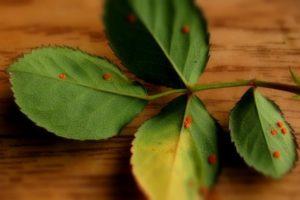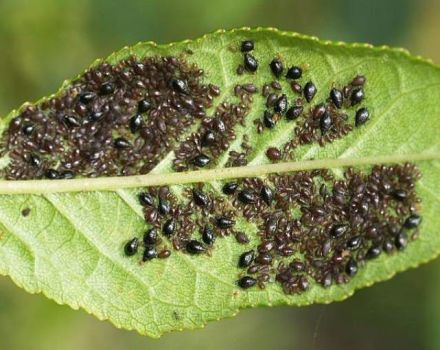Characteristics and description of the Geisha rose variety, cultivation and care
Rose Geisha was bred in 2007 by the German company Tantau. The plant immediately became popular with gardeners all over the world. It is a vigorous, branched flower of the Rosaceae family. Its peculiarity lies in the fact that when the bud is fully opened, the middle remains hidden by the petals located in the center. To safely grow a unique plant, you should familiarize yourself with all the rules for planting, care and reproduction of the Geisha rose.
Description of the Geisha rose and characteristics
Most growers mistakenly call the Geisha floribunda a hybrid tea bush. The plant does not belong to this group, it has a high degree of flower density. The bush is famous for its fast growth, up to 1 meter high, 0.5-0.6 meters wide. The leaves are bright green with a low gloss. The bush regenerates well after transplanting, grows back quickly. The variety is widely used for planting in large tracts. The rose has strong immunity and is resistant to pests and diseases. Severe disease damage occurs in unfavorable years.
Flower characteristic
The shrub blooms profusely and for a long time, it is resistant to frost -23 degrees. The flowers are famous for their extraordinary beauty, amazing shade and a number of other features.
- The lower petals are large, wavy, with a distinctive fold. The upper ones are small, more dense.
- Semi-double flowers up to 50-60 millimeters, orange tint, medium aroma.
- The buds are resistant to showers, do not become stained from wet weather.
- In strong sun, the color may fade, but in the cool it becomes more saturated - apricot.
The variety is perfect for cutting, the petals keep their shape well for 10 days. The plant can survive drought, but if such periods are not regular.
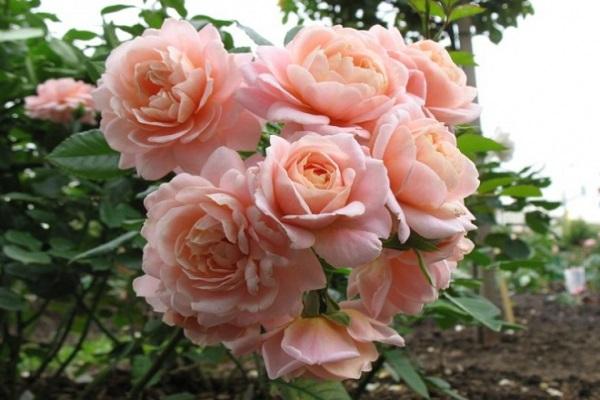
Advantages and disadvantages of the variety
The Geisha rose variety suggests a number of pros and cons, just like other flowers. They will help you decide whether to plant a plant or not.
| Benefits | disadvantages |
| Blooms 3 times per season | In insufficient light, the stems stretch, the flowers lose their shade |
| Withstands low temperatures, which is not typical for roses | Weak incense |
| Drought resistant, high humidity | |
| Strong immunity, resistance to disease and pest attacks | |
| Cut flowers do not lose their original appearance for up to 10 days |
How to grow a crop correctly
There are no special nuances in planting a variety and subsequent care. It is only important to water the bushes correctly and in a timely manner, loosen the soil, and remove weeds. Fertilizing is carried out once a season to replenish the nutrients spent on flowering.
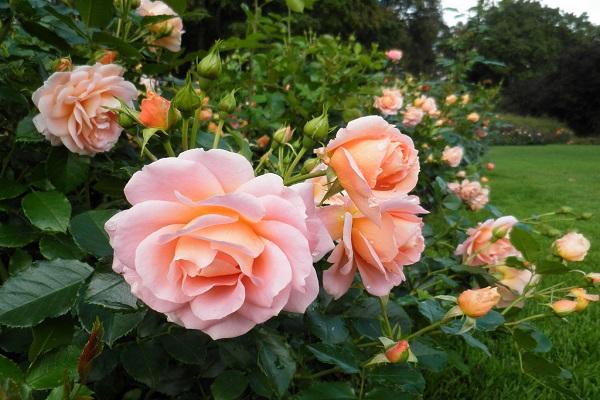
Growing technology assumes the following rules:
- purchase of quality seedlings;
- correct selection of the place;
- suitable soil, previously prepared;
- phased disembarkation with digging holes;
- timely care.
The rose is unpretentious, takes root well in the soil characteristic of the CIS countries.
When to plant a rose
For a floribunda, a Geisha rose, to bloom for a long time and give thick buds, you need to plant it in spring and autumn. It is advisable to plant from mid-April to the end of May, in September or early October, before the first frost. The soil should warm up to a temperature of at least 10 degrees.

Landing place
The area where the rose will grow should be with well-drained, fertile and loose soil. The variety does not tolerate moisture, stagnation in the soil, drainage is needed in the planting holes. It is undesirable to plant floribunda along fences, since shade significantly reduces the quality of flowering. The variety tolerates the scorching sun, high air temperature well; a bright place is perfect for it.
Preparation of planting material
It is advisable to purchase seedlings not of southern varieties, but of Russian or Dutch ones. The stalk must be grafted and rooted, without damage, natural deep green color with brownish tints. For growing floribunda in a greenhouse, southern varieties are also suitable.
Planting scheme and process
The best soil for a plant will be black soil or loam. Such soil is enriched with organic fertilizing. The groundwater level should be up to 1 meter. Floribunda grows well on slightly acidic soil, pH 6.0-6.5. To acidify it, you need to add manure or peat. Excess acid is removed by ash or limestone.

It is necessary to prepare the soil 2 weeks before planting. Dig holes up to 40 centimeters in diameter, so that with further plantings, the distance between the plants is from 40 to 60 centimeters. After planting, the bush needs 3 years before absolute maturation and root formation.
Flower care
It is not difficult to take care of the plant, the main thing is to do it regularly and correctly:
- timely watering, loosening, weeding, weeding;
- applying high-quality fertilizers;
- pruning, mulching, disease and bug protection.
With proper care, the rose will delight you with lush flowers and a sweet, delicate scent.
Watering, weeding and loosening
Sanitize the earth abundantly, but after the soil dries out. The water should be warm and settled. 1 bush takes up to 10 liters. Do not wet foliage and flowers, especially in the heat. Pour water exclusively at the root.
After watering, they begin to loosen the soil so that it has access to oxygen. Weeds must be removed without fail, it provokes rotting of the roots, the appearance of mold.

Fertilization
In early spring, fertilize the rose with a urea solution, bring it under young and already formed bushes. At the end of August, stop adding nitrogen ingredients and increase the volume of phosphorus and potassium feeds, wood ash.
Pruning
The bush should not bloom in the first year; for this, the buds are cut. You can leave some buds at the end of summer. Thereafter, prune the rose every year. Shorten annual shoots up to 30% of the length, and perennial ones - up to 5 eyes. Remove branches without buds completely.
Wintering
In the CIS countries, roses are covered for the winter when the temperature drops from -7 degrees. Previously, the plant is spud with peat, sand or wood dust. The best shelter would be fir branches. They lay it between the bushes and on top of them, set wire frames 20 centimeters above the rose.Insulating material is laid on them, cling film is pulled on top, leaving gaps on the sides. From the beginning of April, you can ventilate by opening the sides of the shelter. It is necessary to completely remove the frame when the air temperature warms up to 10 degrees and there will be no night frosts.

Pest control
Most often, floribunda is affected by aphids, spider mites, which can cause the death of the bush. Weeds provoke the attack of the leaves by molds, the growth of root rot.
Protection from ailments
The bushes should be inspected regularly in order to detect diseases in a timely manner, preventive treatment with insectofungicides will help to avoid them. Pathologies usually develop with waterlogged earth, insufficient oxygen supply. Roses need to be treated with special "preparations" - Gamair, Topaz, Alirin-B, Glyokladin.

Breeding varieties
To preserve the varietal characteristics of the floribunda, it must be propagated vegetatively. The most popular method is grafting. They should be taken from grown and strengthened bushes after the first wave of flowering.
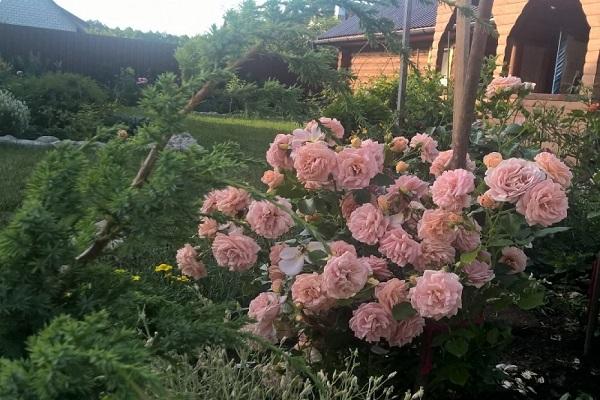
Application in design
Geisha rose goes well with different plants. These include:
- undersized lilac;
- yellow acacia;
- scumpia;
- cotoneaster,
- garden sea buckthorn;
- chubushnik.
Classic plantings with pinkish bushes can be supplemented with conifers: spruce, juniper and thuja.

